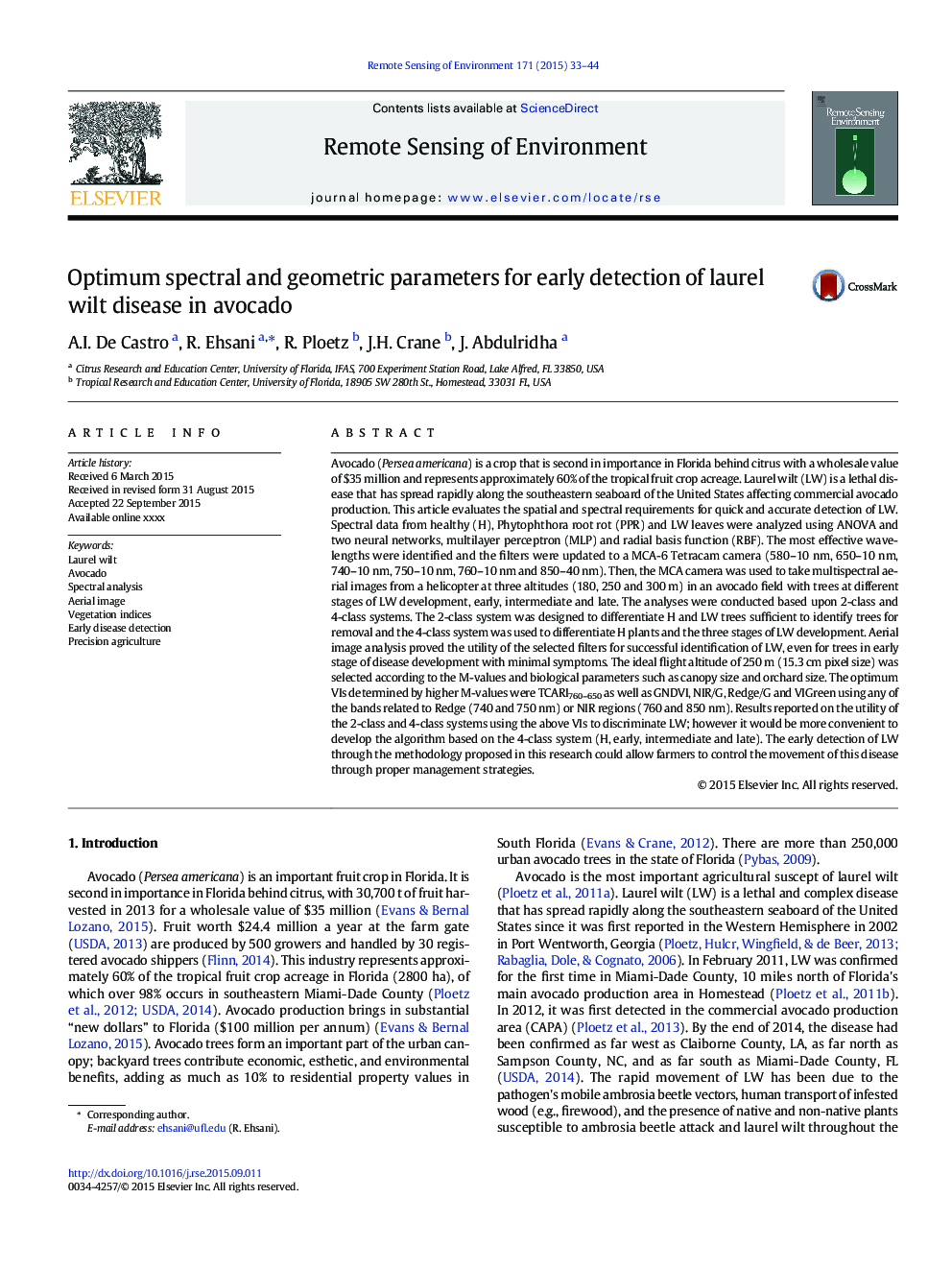| کد مقاله | کد نشریه | سال انتشار | مقاله انگلیسی | نسخه تمام متن |
|---|---|---|---|---|
| 6345740 | 1621229 | 2015 | 12 صفحه PDF | دانلود رایگان |
عنوان انگلیسی مقاله ISI
Optimum spectral and geometric parameters for early detection of laurel wilt disease in avocado
ترجمه فارسی عنوان
پارامترهای طیفی و هندسی بهینه برای تشخیص زودرس بیماری لورل ویلد در آوکادو
دانلود مقاله + سفارش ترجمه
دانلود مقاله ISI انگلیسی
رایگان برای ایرانیان
کلمات کلیدی
لورل وود، آووکادو، تجزیه طیفی، تصویر هوایی، شاخص های گیاهی تشخیص بیماری های اولیه، کشاورزی دقیق،
موضوعات مرتبط
مهندسی و علوم پایه
علوم زمین و سیارات
کامپیوتر در علوم زمین
چکیده انگلیسی
Avocado (Persea americana) is a crop that is second in importance in Florida behind citrus with a wholesale value of $35 million and represents approximately 60% of the tropical fruit crop acreage. Laurel wilt (LW) is a lethal disease that has spread rapidly along the southeastern seaboard of the United States affecting commercial avocado production. This article evaluates the spatial and spectral requirements for quick and accurate detection of LW. Spectral data from healthy (H), Phytophthora root rot (PPR) and LW leaves were analyzed using ANOVA and two neural networks, multilayer perceptron (MLP) and radial basis function (RBF). The most effective wavelengths were identified and the filters were updated to a MCA-6 Tetracam camera (580-10Â nm, 650-10Â nm, 740-10Â nm, 750-10Â nm, 760-10Â nm and 850-40Â nm). Then, the MCA camera was used to take multispectral aerial images from a helicopter at three altitudes (180, 250 and 300Â m) in an avocado field with trees at different stages of LW development, early, intermediate and late. The analyses were conducted based upon 2-class and 4-class systems. The 2-class system was designed to differentiate H and LW trees sufficient to identify trees for removal and the 4-class system was used to differentiate H plants and the three stages of LW development. Aerial image analysis proved the utility of the selected filters for successful identification of LW, even for trees in early stage of disease development with minimal symptoms. The ideal flight altitude of 250Â m (15.3Â cm pixel size) was selected according to the M-values and biological parameters such as canopy size and orchard size. The optimum VIs determined by higher M-values were TCARI760-650 as well as GNDVI, NIR/G, Redge/G and VIGreen using any of the bands related to Redge (740 and 750Â nm) or NIR regions (760 and 850Â nm). Results reported on the utility of the 2-class and 4-class systems using the above VIs to discriminate LW; however it would be more convenient to develop the algorithm based on the 4-class system (H, early, intermediate and late). The early detection of LW through the methodology proposed in this research could allow farmers to control the movement of this disease through proper management strategies.
ناشر
Database: Elsevier - ScienceDirect (ساینس دایرکت)
Journal: Remote Sensing of Environment - Volume 171, 15 December 2015, Pages 33-44
Journal: Remote Sensing of Environment - Volume 171, 15 December 2015, Pages 33-44
نویسندگان
A.I. De Castro, R. Ehsani, R. Ploetz, J.H. Crane, J. Abdulridha,
